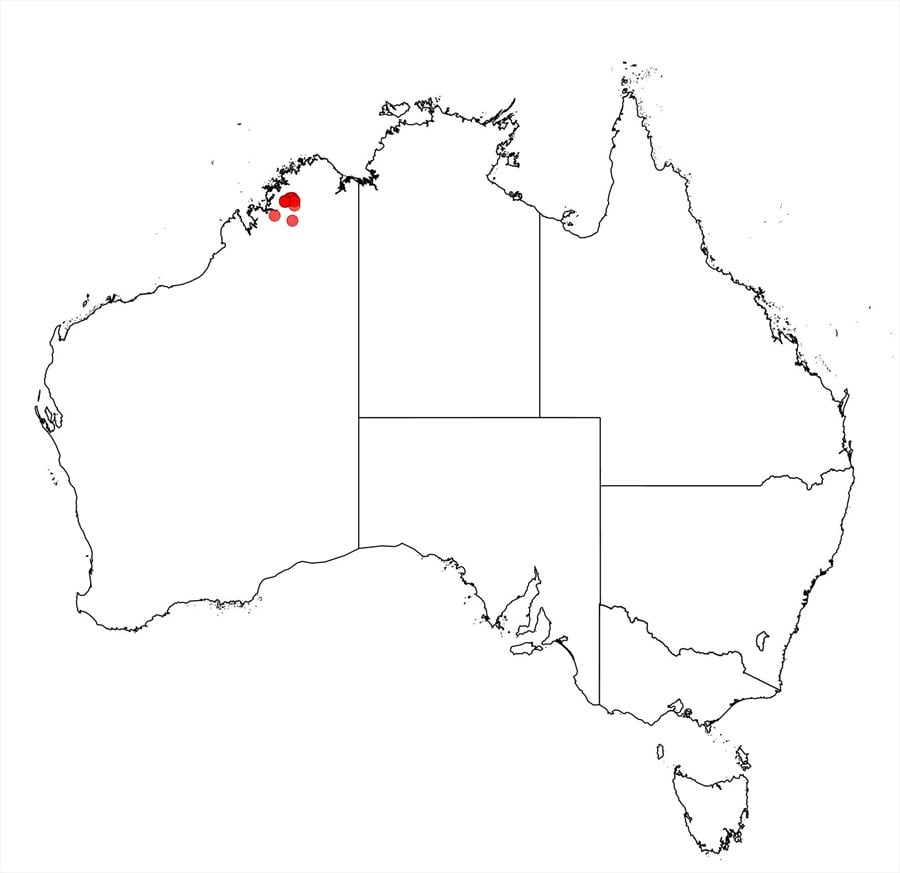Acacia prolata Maslin, M.D.Barrett & R.L.Barrett
WATTLE
Acacias of Australia
Common Name
Gardner Plateau Whorled Wattle
Family
Fabaceae
Distribution
Occurs in the Kimberley region of northern W.A. where it is relatively common through the northern Edkins Ra. and southern Prince Regent Natl Park, with an apparent disjunct occurrence on Mt Hart Stn, c. 100 km to the SE.
Description
Erect, spreading, slightly viscid shrub 0.5–1 m tall. Branchlets pubescent with weak, slightly to prominently retrorse hairs. Stipules 1–1.5 (–2) mm long. Phyllodes 10–20 per whorl, (3–) 4–8 (–10) mm long (excluding mucro), infrequently dimorphic with those subtending inflorescences c. ½ length of the others, 0.3–0.5 mm wide, straight to shallowly curved, recurved at apex, sub-terete to flat; longitudinal nerves ±not visible; mucro distinct, ±setose, 0.5–1.5 (–2) mm long. Peduncles 10–20 mm long; heads 25–35-flowered. Bracteoles lanceolate to narrowly lanceolate, 1.5–2 mm long, 0.15–0.3 mm wide, acuminate. Flowers 5-merous; sepals ±½ length of petals, mostly free, oblong to narrowly oblong or ±linear, glabrous; petals striate but often obscurely so, ±glabrous. Pods ±sessile, 4.5–8 cm long, 5–7 mm wide, flat but raised over seeds along midline, reticulately nerved. Seeds longitudinal to longitudinally oblique, black, dull except slightly shiny at centre, aril clavate.
Phenology
Flowers in Jan., Feb. and June during which time plants also possess mature pods.
Habitat
Grows on sandstone slopes and ridges, often with Triodia ground cover.
Specimens
W.A.: 6.9 km WNW of Mt Hann, M.D. & R.L.Barrett MDB 2867B (BRI, NSW, MEL, PERTH); Humbert Yard Creek, 22 km NW of Mt Hart Station, 29 June 1987, D.J.Edinger 516 (CANB, DNA, PERTH).
Notes
As with many taxa of sect. Lycopodiifoliae the general facies of juvenile plants of A. prolata differs from that of mature plants. In this species the phyllodes of the juveniles are characteristically erect (not ascending to patent) and some are slightly longer (to 12 mm) than those of mature individuals.
Closely related to A. dimorpha and A. smeringa which are most readily distinguished by their patent (not retrorsely curved) branchlet hairs and clearly united sepals; see B.R. Maslin, M.D.Barrett & R.L.Barrett, Nuytsia 23: 584 (2013), for further discussion. Also related to A. claviseta which is readily distinguished by yellow on the upper branchlets, young phyllodes, peduncles and petals, and also by the often clearly clavate phyllode mucro. Acacia anasilla, A. mackenziei and A. lycopodiifolia are perhaps not far removed from A. prolata but are distinguished by their united sepals that are clearly less than half the length of the petals.
FOA Reference
Flora of Australia Project
Author
Minor edit B.R.Maslin
This identification key and fact sheets are available as a mobile application:
URL: https://apps.lucidcentral.org/wattle/
© Copyright 2018. All rights reserved.






